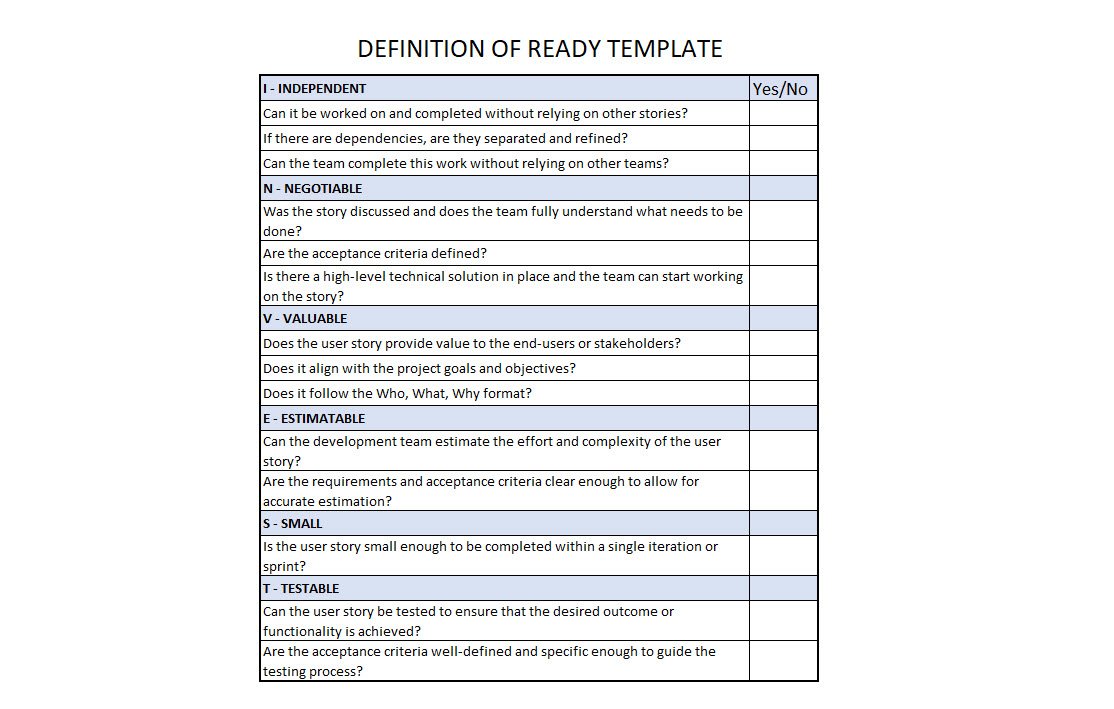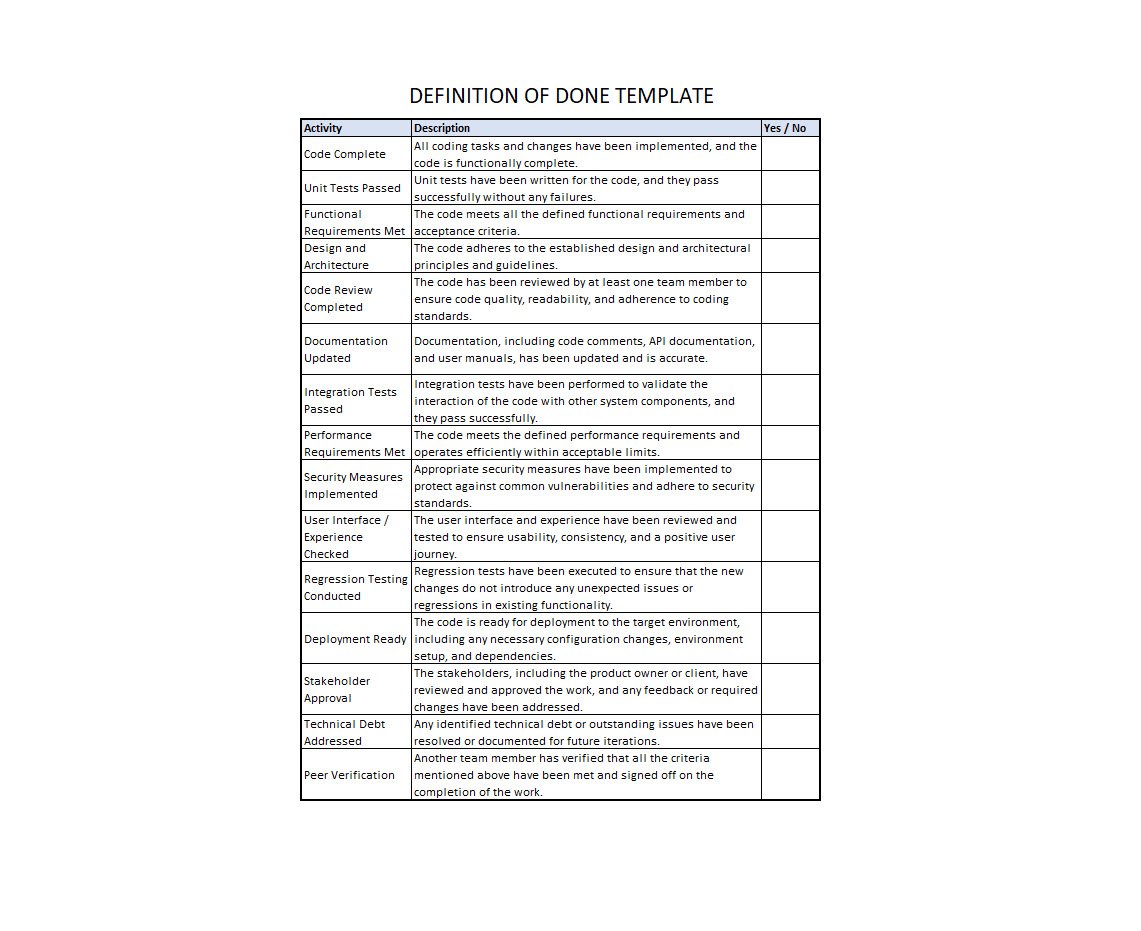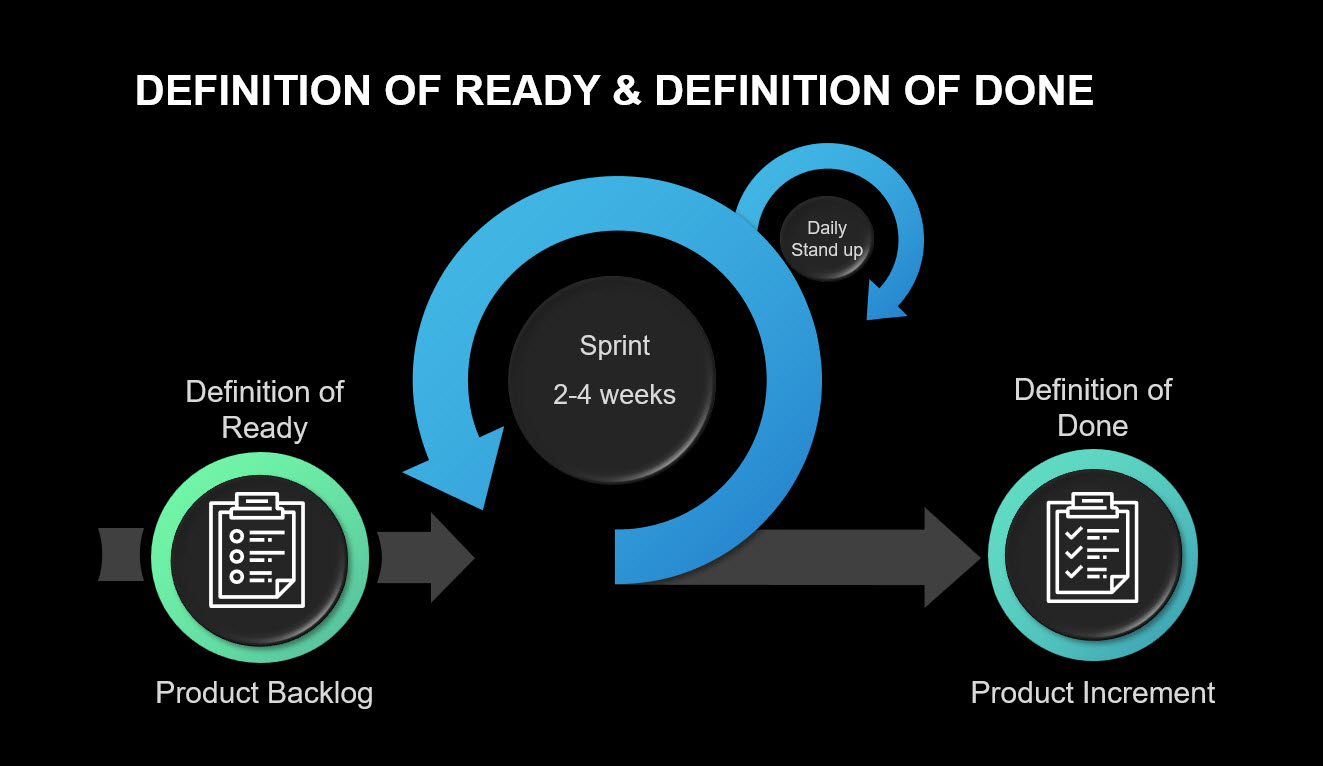Table of Contents
In the fast-paced world of software development and product management, where timelines are tight and expectations run high, finding the perfect balance between productivity and quality can be a daunting task. That’s where the Definition of Ready (DoR) and the Definition of Done (DoD) step in as the dynamic duo of agile methodologies, ensuring smooth sailing from start to finish.
Imagine a scenario where teams plunge headfirst into development without a clear understanding of the requirements of the desired outcome. Chaos ensues, deadlines slip, and quality suffers. But fear not, for the DoR emerges as the beacon of clarity, guiding teams to craft well-defined user stories and tasks before embarking on their agile journey.
But wait, there’s more! Just as the DoR lays the groundwork, the DoD swoops in as the ultimate yardstick of completeness. It sets the bar for when a user story or task can be considered truly finished, leaving no room for ambiguity. The secret sauce elevates your work from mere functionality to a polished gem that meets the highest standards.
In this article, I will delve deep into the realm of DoR and DoD, uncovering their true essence and unraveling their extraordinary power in driving agile efficiency. I’ll explain their interdependence, discover the crucial elements that constitute them, and unravel practical tips for implementation and evolution. So fasten your seatbelts as we embark on a journey that will revolutionize the way you approach product management and software development.
Let’s dive in and unleash the true potential of agile product management.
Definition of Ready (DoR)
At the heart of successful agile product management lies the Definition of Ready (DoR) – a powerful tool that sets the stage for effective collaboration and streamlined development.
But what exactly is the DoR?
The DoR can be understood as a checklist or a set of criteria that user stories or tasks must meet before they are deemed ready for inclusion in a sprint. It serves as a gatekeeper, ensuring that each item in the product backlog is well-defined, thoroughly understood, and adequately prepared to be worked on by the development team.
The primary purpose of the DoR is to eliminate ambiguity and reduce the likelihood of misunderstandings between stakeholders, the product owner, and the development team. By establishing a common understanding of what it means for a user story or task to be “ready,” the DoR fosters effective collaboration, mitigates risks, and sets the foundation for a successful development process.
A typical DoR includes several key elements that collectively define the readiness of a user story or task. These elements may vary based on the specific needs of a product, but generally, they include:
- Clear and well-defined acceptance criteria: The user story or task should have explicit criteria determining when it is complete, leaving no room for ambiguity or subjective interpretation.
- Detailed story or task description: A comprehensive description, often accompanied by relevant mockups, wireframes, or diagrams, helps ensure that everyone involved understands the purpose, scope, and desired outcome.
- Estimates and sizing: The development team should estimate the effort required to complete the user story or task accurately. This aids in capacity planning and ensures that the work fits within the sprint’s timeframe.
- Dependencies and prerequisites: Identify any dependencies on external factors, such as specific data sources or integration requirements, that must be resolved before the work can begin.
- Clarity on user roles and personas: It is crucial to identify and understand the target audience, their needs, and their interactions with the software to ensure the user story adequately addresses their requirements.
By adhering to these elements and tailoring them to the product’s unique characteristics, the DoR becomes a powerful ally in streamlining the agile development process. It empowers the development team to work on well-defined and feasible tasks, reduces rework and delays, and promotes a shared understanding of the work at hand.
Download the Definition of Ready templates

Definition of Done (DoD)
Complementing the Definition of Ready (DoR) is the Definition of Done (DoD) – an essential concept in agile product management that determines the criteria for a user story or task to be considered complete. While the DoR focuses on readiness, the DoD ensures that work is finished to a certain standard and meets the expected quality levels.
The DoD acts as a crucial agreement and shared understanding among team members, stakeholders, and the product owner about what it means for a user story or task to be truly “done.” By explicitly defining the DoD, teams avoid assumptions, prevent premature declarations of completion, and foster transparency and accountability throughout the development process.
A well-crafted DoD typically consists of specific criteria or conditions that must be met for a user story or task to pass the finishing line. While the exact elements may vary depending on the product, some common components of a DoD include:
- Code review and quality: The code should thoroughly review to ensure readability, maintainability, and adherence to coding standards. It should be free from major defects and aligned with the team’s coding practices.
- Unit tests and test coverage: The development team must create and execute unit tests to verify the correctness of their implementation. The coverage should be sufficient, aiming to cover critical and high-risk areas of the codebase.
- Integration and system testing: Once the user story or task is implemented, it should undergo integration testing to ensure seamless functionality within the larger system. This includes testing interactions with other components, APIs, or databases.
- Documentation: The necessary documentation, such as user manuals, technical documentation, or release notes, should be created or updated to reflect the changes made in the user story or task.
- User acceptance testing: The user story or task should be subjected to user acceptance testing to validate that it meets the end-users requirements and expectations.
- Performance and scalability: If relevant, the user story or task should be tested for performance and scalability to ensure it can handle expected workloads without significant degradation.
By defining and adhering to a comprehensive DoD, teams ensure that their work is not only functionally complete but also meets the quality standards necessary for successful delivery. It provides a shared understanding of the expected outcomes, avoids misunderstandings, and facilitates a smoother handover to the stakeholders or end-users.
It’s worth noting that the DoD is not static and should evolve. It should adapt to the specific needs of the product, incorporate lessons learned, and reflect the desired quality standards. Regularly revisiting and refining the DoD fosters continuous improvement and helps teams strive for excellence in every increment they deliver.
Download the Definition of Done templates

Relationship Between Definition of Ready and Definition of Done
In the realm of agile product management, the Definition of Ready (DoR) and the Definition of Done (DoD) are not isolated concepts but rather two sides of the same coin. They form a powerful symbiotic relationship, working in tandem to drive efficiency, collaboration, and quality throughout the development process.
The DoR and DoD are interdependent, with each serving a distinct purpose that complements the other.
- DoR sets the stage for action: The DoR acts as the gatekeeper, ensuring that user stories or tasks are adequately prepared before they enter the development phase. It defines the criteria that must be met for work to be deemed ready. By clarifying the requirements, establishing acceptance criteria, and addressing dependencies, the DoR prepares the groundwork for the development team to hit the ground running.
- DoD marks the finish line: Once work begins on a user story or task, the DoD comes into play, outlining the criteria that must be satisfied for the work to be considered complete. It defines the quality standards, testing requirements, and documentation expectations that need to be fulfilled. The DoD ensures that the development team delivers work that meets the agreed-upon definition of “done” and aligns with the product’s quality objectives.
The relationship between the DoR and DoD is collaborative and iterative.
- Collaborative nature: The DoR is usually defined collaboratively by the product owner, development team, and other relevant stakeholders. It leverages the collective knowledge and insights of the team to ensure a shared understanding of the requirements and expectations. Similarly, the DoD benefits from collaboration, with the development team and stakeholders working together to define the quality standards and criteria for completion.
- Iterative improvement: Both the DoR and DoD are not set in stone; they evolve and improve over time. As the team gains experience, they refine and adjust the criteria based on lessons learned, changing product needs, and evolving industry practices. Regular retrospectives and feedback loops allow the team to continuously enhance the DoR and DoD, fostering a culture of continuous improvement and adaptability.
The synergy between the DoR and DoD drives several benefits within agile development:
- Clarity and shared understanding: The DoR and DoD ensure that everyone involved in the product, including the product owner, development team, and stakeholders, has a clear and shared understanding of what it means for work to be ready and done. This clarity minimizes misunderstandings, reduces rework, and facilitates effective communication.
- Transparency and accountability: The DoR and DoD promote transparency by establishing clear expectations and criteria for readiness and completion. They hold the team accountable for meeting those standards, fostering a sense of responsibility and ownership.
- Efficiency and productivity: The DoR helps optimize the development process by ensuring that work is well-defined and ready to be worked on. This reduces delays, prevents wasteful efforts, and enhances efficiency. Meanwhile, the DoD ensures that work is completed to a high standard, minimizing defects and the need for rework, and ultimately improving overall productivity.
Implementing and Evolving the Definition of Ready and the Definition of Done
Implementing and evolving the Definition of Ready (DoR) and the Definition of Done (DoD) is a dynamic and iterative process that requires active involvement and collaboration from the agile team. By following some key guidelines and best practices, teams can establish effective DoR and DoD practices and continuously improve them as the product progresses.
Implementing the Definition of Ready
- Collaborative definition: Involve the product owner, development team, and other relevant stakeholders in defining the DoR. Encourage open discussions to gather different perspectives and ensure a shared understanding.
- Tailor to product needs: Customize the DoR to suit the specific requirements of your product. Consider factors such as the complexity of the work, team expertise, and product constraints while defining the criteria for readiness.
- Make it specific: Ensure that the DoR criteria are clear, concise, and unambiguous. Avoid vague statements and include specific details, such as acceptance criteria, mockups, or wireframes, to leave no room for misinterpretation.
- Review and refine: Regularly review and refine the DoR to adapt to evolving product needs. Encourage feedback from the team and stakeholders to identify areas for improvement and make necessary adjustments.
Implementing the Definition of Done
- Collaborative definition: Similar to the DoR, involve the development team, product owner, and stakeholders in defining the DoD. Leverage their collective expertise to establish quality standards and criteria for completion.
- Set measurable criteria: Define specific and measurable criteria that must be met for work to be considered done. This may include aspects like code review, testing, documentation, and other quality-related checkpoints.
- Continuous testing and feedback: Integrate testing activities throughout the development process to validate compliance with the DoD. Encourage frequent feedback from stakeholders to identify any gaps or areas for improvement.
- Evolve with product growth: As the product evolves, reassess and update the DoD to align with changing requirements, emerging best practices, and lessons learned. This ensures that the DoD remains relevant and effective throughout the product lifecycle.
Fostering Continuous Improvement
- Retrospectives: Regularly conduct retrospectives to reflect on the effectiveness of both the DoR and DoD. Gather insights from the team and stakeholders, identify bottlenecks, and implement changes to enhance their efficiency.
- Feedback loops: Encourage feedback from all stakeholders, including the product owner, development team, and end-users. This feedback helps identify areas where the DoR and DoD can be refined to better meet expectations and deliver increased value.
- Learn from experience: Continuously learn from past experiences and projects. Analyze the outcomes of completed user stories or tasks, identify any gaps in the DoR or DoD, and use those insights to refine and improve future iterations.
- Promote a culture of quality: Foster a culture that values quality and continuous improvement. Encourage team members to take ownership of the DoR and DoD, promote collaboration, and emphasize the importance of delivering work that meets the defined standards.
Challenges and Best Practices
Implementing the Definition of Ready (DoR) and the Definition of Done (DoD) can bring substantial benefits, but it also presents challenges that teams must overcome. Understanding these challenges and adopting best practices is crucial to effectively leverage the power of DoR and DoD.
Challenges of Definition of Ready and Definition of Done
- Lack of Clarity: Defining unambiguous criteria in DoR and DoD can be challenging. Ambiguity or gaps in the definitions can lead to misunderstandings and delays.
- Resistance to Change: Teams transitioning to DoR and DoD practices may face resistance. Some team members might find it difficult to adapt to the new requirements and criteria.
- Balancing Detail and Efficiency: Striking the right balance between a comprehensive DoR and a manageable workload can be a challenge. Overly detailed DoR criteria may increase overhead and slow down the development process.
- Evolution and Maintenance: Evolving and maintaining DoR and DoD requires ongoing effort. Regularly revisiting and updating these definitions can be time-consuming and compete with other project priorities.
Best Practices for Definition of Ready and Definition of Done
- Collaborative Definition: Involve the entire team, including the product owner and stakeholders, in defining the DoR and DoD criteria. This ensures a shared understanding and buy-in from all parties.
- Clear and Specific Criteria: Make sure the DoR and DoD criteria are well-defined, clear, and measurable. Use concrete examples and provide explicit acceptance criteria to avoid ambiguity.
- Continuous Refinement: Regularly review and refine the DoR and DoD definitions as the project progresses. Embrace feedback and incorporate lessons learned to ensure their relevance and effectiveness.
- Education and Training: Provide training and support to help the team understand the importance and benefits of DoR and DoD. Foster a learning environment to promote adoption and ongoing improvement.
- Iterative Approach: Treat DoR and DoD as living documents that evolve. Embrace an iterative approach to refine and adapt the criteria based on changing project needs and feedback.
- Transparent Communication: Maintain open and transparent communication channels within the team and with stakeholders. Communicate the purpose and significance of DoR and DoD to foster understanding and alignment.
Conclusion
In the world of agile product management, the Definition of Ready (DoR) and the Definition of Done (DoD) serve as vital pillars that uphold the principles of collaboration, transparency, and continuous improvement. By establishing clear criteria for readiness and completion, DoR and DoD provide a roadmap for teams to navigate the complexities of development and deliver high-quality increments with efficiency and accountability.
Implementing DoR and DoD is not without its challenges, but the benefits they bring far outweigh the initial difficulties. The challenges, such as initial resistance, maintaining clarity, and finding the right balance, can be overcome through open communication, collaboration, and a commitment to iterative improvement. With diligent effort and a focus on evolving best practices, teams can successfully implement and refine their DoR and DoD processes.
The benefits of DoR and DoD are substantial. Improved clarity and alignment lead to better understanding and communication among team members and stakeholders. Enhanced collaboration and productivity result in streamlined development processes and reduced rework. Mitigating risks and uncertainty upfront ensures smoother project execution. Increased transparency and accountability foster trust and enable informed decision-making. Furthermore, the continuous improvement mindset supported by DoR and DoD drives excellence and higher-quality deliverables.
To fully leverage the power of DoR and DoD, agile teams must embrace a culture of collaboration, learning, and adaptation. Regularly reviewing, refining, and evolving the DoR and DoD based on product needs and feedback ensures their relevance and effectiveness throughout the product development lifecycle. By consistently striving for excellence, teams can navigate the path to agile success, delivering valuable products that meet or exceed stakeholder expectations.
The Definition of Ready and Definition of Done is more than just concepts; they are guiding principles that empower agile teams to achieve their goals. By adopting and continuously improving these practices, teams pave the way for efficient collaboration, quality-driven development, and successful product outcomes.
Embrace the power of DoR and DoD, and unlock the full potential of agile product management.
What are some of the lessons learned after using DoR and DoD you can share? Let me know in the comments.


